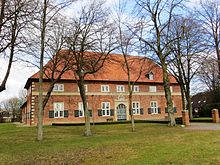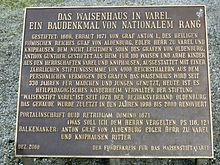Orphanage (Varel)
The Vareler Waisenstift is a listed orphanage in the Lower Saxony town of Varel , built in the second half of the 17th century. The monastery still serves the original purpose of the foundation today.
Location and structure
At the western entrance to the city, the imposing facade of the orphanage has an impact on the viewer. The brick building is U-shaped, two-storey in the main building facing the street and one-storey in the two wings. Above the entrance door on the central building an inscription reads: “QUID RETRIBUAM DOMION AD 1671” (“How should I show myself thankful to the Lord 1671”).
The first outdoor living group was housed in a residential building in Rastede in 1982 , the second group followed a year later in a house in Winkelsheide and in 1992 a third residential building in Rallenbüschen was acquired. In addition to the main building, there is another administration building and three houses for children built in 1980 on the original site of the orphanage.
Todays use
The foundation idea is still implemented today; Children are still accommodated and taught in the shared apartments and in the main building. The orphanage is a special educational children's home whose premises are also used culturally, among other things.
Since the extensive restoration, the main building can again be used in a variety of ways, for example the so-called rain room can be used for weddings and events. In addition, regular events such as the Christmas concerts take place in the orphanage.
history
17th century
The history of the orphanage is closely related to the history of the people in Varel . In 1663, Count Anton Günther from Oldenburg bequeathed his illegitimate son Anton I von Aldenburg the Noble Lordship of Varel, the Bailiwick of Jade and the Free Lordship of Kniphausen . Long negotiations and high compensation payments made these transfers possible at all.
Probably also as a thank you to his father, Anton I had the orphanage built between 1669 and 1671. The basic social idea regarding the establishment of special orphanages is a rather modern aspect that is outstanding for this time. Nevertheless, the founding corresponded to the Pietist aspirations of the time and the building is, next to the castle church and after the demolition of the castle, the only stately building of architectural historical importance that is still preserved.
The background of the orphanage as a separate institution includes a pedagogical claim: “Here, materially and mentally and spiritually unsupervised children should be brought to the point of being useful to society or at least not to be a burden to it later, through religious institutional education, combined with simple professional training to fall. ”Before the foundation was completed, Anton I died on October 27, 1680. As a result, the Danish King Christian V had ownership claims that threatened Varel's independence again. The Oldenburg Treatise of July 12, 1693 ended the negotiations with the result that the Noble Lordship of Varel was under the sovereignty of Denmark , but was owned by the Aldenburgs.
18th century
The situation of the orphanage at the beginning of the 18th century was marked by financial and administrative grievances. The damage from storm surges meant high restoration costs, some of which were granted by the Oldenburgische Deichkasse with repayment periods. The Christmas flood of 1717 forced Anton II , the son of Anton I, to sell the Schweiburg lands, as no financial alternatives were possible. Anton II died in 1738. The original capital of the orphan's foundation fell from 21,287 Thalers (1716) to only 5,734 Thalers (1738). After the death of Anton II, his daughter Charlotte Sophie took over her inheritance and married Wilhelm von Bentinck , who rose to become imperial count ; the marriage was divorced shortly thereafter in 1740. The total debt increased further and Varel was placed under Oldenburg rule. Thus Varel passed from Aldenburger property to the Bentincks.
Count Christian Friedrich Anton von Bentinck Varel ruled in the years 1759–1768 and the financial situation slowly relaxed. Through further donations the capital of the monastery grew again in 1777 to 25,964 thalers. In 1811 Varel and Oldenburg were annexed by the French Empire and the interest on the orphanage did not materialize. During the occupation, the building was used as a military hospital , warehouse and finally as a prison. The strength of the Count von Bentinck prevented further interference by the French. For Count Wilhelm Gustav Friedrich (son of Christian Friedrich Anton) it was the highest priority in the following years to win back the dominions of Kniphausen and Varel. He made his request clear at the Congress of Vienna , but was only heard at the Congress of Aachen in 1818. The recovery of the rights to Varel and Kniphausen is recorded in the Berlin Treaty formulated in 1825.
19th century
Years of inheritance disputes with heirs in Holland and England meant that the Oldenburg State ended the counts in 1854 by purchasing Varels and Kniphausen. The purchase resulted in an economic upswing, Varel became an important industrial location in the Oldenburger Land ("Manchester of Northern Germany"). In addition to shipping, the craft also developed further; at the same time there were fundamental changes in the administration. Since Varel became 1st class town in 1858 with its own town council elected by the citizens, the orphanage was converted into a municipal institution a few years later. Administration lay directly with the state.
20th century
In the following years the orphanage took in up to 38 children at the same time and was further expanded. The next restructuring took place in 1978: a change of concept towards a special educational children's home with changes in the statutes, new structural and organizational solutions were urgently needed. As a result, three residential buildings were purchased between 1982 and 1992 to accommodate outdoor living groups and thus enable more intensive care in small groups. The current sponsor of the house is the Oldenburg district association. It has been possible to remain faithful to the foundation's purpose for over 300 years and to defend it. In 1996 the building was named a mundane "monument of national rank" according to an appraisal by the State Office for the Preservation of Monuments , and in this way subsidies for preservation and renovation were made possible.
Renovation work
Even when the monastery was founded, the building represented something seldom significant. Built in the Dutch Renaissance style, after centuries of use, towards the end of the 20th century it had massive defects that had to be remedied. An appraisal from 1990 showed that the roof beam construction, which was originally left in place, was rotting from the inside. Several million marks were raised by a development association, the city of Varel, the state of Lower Saxony , the Lotto Foundation, the Weser-Ems district government and the Friesland district in order to be able to finance a renovation in three stages. Between 1996 and 2000, the lead architect Hans-Heino Predel managed to correct faulty renovations and to provide the roof with a kind of metal support in order to restore stability. The floors on the upper floors had to be renewed because the old floorboards had warped. In addition, the facade was carefully cleaned and the front lettering restored. All work required great care so as not to cause further damage. Originally, an old graft ran around the building, which was extended by a bend to restore the historical course. The appointment of the orphanage as a "monument of national standing" made it possible to use the federal funds necessary for the renovation. Before that, a major renovation was not possible for reasons of cost.
literature
- Wilhelm Janßen, Claus Soltau, Karl-Erich Speith: The orphanage in Varel and its founder Anton I. von Aldenburg . In: Heimatverein Varel eV (ed.): Vareler Heimathefte, Issue 12 - Allmers, Varel 1987, ISBN 3924113319 .
- Ursula Maria Schute: The orphanage in Varel . In: Mitteilungsblatt der Oldenburgische Landschaft, No. 91, 1996, 8-11, ISSN 0175-7512 .
- Martin Wenz: The orphanage in Varel . In: Reports on the preservation of monuments in Lower Saxony, 1/2001, 21f.
- Edel Marzinek-Späth: New splendor for an old orphanage . In: Ostfriesland Magazin. 1/2001, 84f.
- Helmut Popken: A “monument of national standing” . In: Ostfriesland Magazin. 9/1997, 92ff.
Web links
Coordinates: 53 ° 23 '54.1 " N , 8 ° 7' 37.6" E




